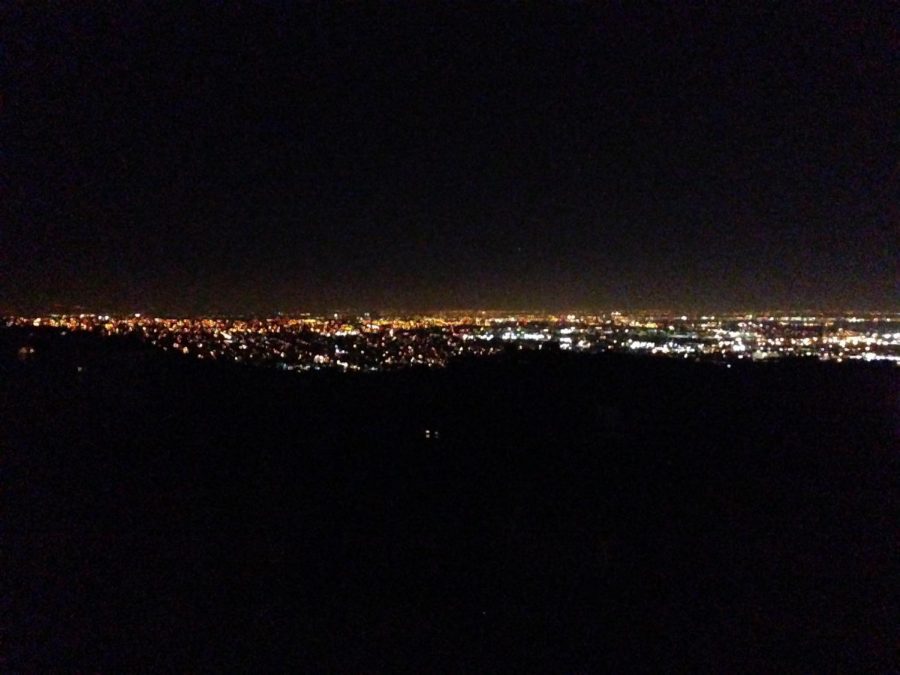New Science Advances study discovers alarming increase in global levels of light pollution
The Milpitas skyline after dark. A new study has discovered that the global light pollution problem is worsening.
December 3, 2017
Over the years, the falling price and rising efficiency of LEDs have proven to be a blessing—and now are proving to be a curse. According to a recent study about our planet’s worsening light pollution problem published in peer-reviewed scientific journal “Science Advances” last Wednesday, the area of Earth lit at night has increased by 2.2 percent and the planet’s overall radiance 1.8 percent every year from 2012 to 2016.
Citing the “continued improvement in the luminous efficacy of light sources and increases in GDP” as reasons many countries have switched from other light sources to LEDs or expanded their use of LEDs, the 10 authors of the study used a satellite equipped with a Visible Infrared Imaging Radiometer Suite Day-Night Band (VIIRS DNB) sensor to measure changes in levels of light emissions from various regions on Earth. The system calibrated nighttime radiance using a scale of 500 to 900 nm, a range close to that of the visible spectrum of light.
VIIRS DNB recorded growth in lighting throughout South America, Africa and Asia, while Yemen and Syria, countries currently experiencing warfare, saw decreases. The United States, the Netherlands, Italy and Spain, some of Earth’s brightest areas, remained stable in light levels throughout the time period.
“In the near term, it appears that artificial light emission into the environment will continue to increase, further eroding Earth’s remaining land area that experiences natural day-night light cycles. This is concerning, because artificial light is an environmental pollutant,” the study said. “In addition to threatening the 30 percent of vertebrates and more than 60 percent of invertebrates that are nocturnal, outdoor artificial light also affects plants and microorganisms and is increasingly suspected of affecting human health.”
Many metropolitan cities, especially Milan, logged decreases in radiance in the city center but increases in outlying areas. The study attributes this trend to the shift from sodium vapor lamps to LEDs in busier and more affluent regions; many city street lights now shine LED white, while other regions remain yellow or orange.
This ongoing movement to replace electrical filament, plasma and gas-powered bulb systems with newer light sources is known as the “lighting revolution” and has been driven by technological developments in the quality of LEDs, which emit little heat compared to their counterparts; incandescent bulbs release 90 percent and compact fluorescent lamps (CFLs) around 80 percent of their energy as heat.
According to the U.S. Department of Energy, residential LEDs use at least 75 percent less energy and last 25 times longer than incandescent bulbs. Good-quality LEDs can be used for around 25,000 to 35,000 hours, averaging out to around 3.5 years, and are projected to reach a useful life of 50,000 hours by 2019. As a result of these improvements in LED efficiency, the price of LEDs has fallen by more than 90 percent from its $70 price tag in 2010.
These factors contribute to LEDs’ growth in popularity as more and more homes and companies turn to LED lighting as an energy-saving and affordable lighting option. However, the benefits of LED lighting are currently offset by the greater levels of light pollution they cause. Although VIIRS DNB cannot detect light in the range of 400 to 500 nm, where white LEDs lie, this decrease in recorded radiance is counteracted by the fact that new lights are being added in other places.
“Technological innovations intended to improve the efficiency of energetically costly systems do not necessarily reduce energy consumption or environmental impact. Cases where higher efficiency leads to greater consumption rather than reduced energy use are known as rebound effects,” German Research Center for Geoscience researcher Christopher Kyba wrote in his abstract “Redefining efficiency for outdoor lighting.“ “For example, although luminous efficiency has doubled over the past 50 years in the UK, per capita electricity consumption for lighting increased fourfold.”
Light pollution’s effects on the ecosystem mainly pertain to its disruption of organisms’ circadian cycle, an internal clock regulating biological processes such as brain wave activity, hormone production and cell regeneration, to function. While organisms living in environments with natural levels of light are able to thrive, the interference of artificial light can change the way they develop and reproduce.
The impacts of artificial light on humans include its negative effects on human behavior and sleep patterns. A 2015 Harvard University study discovered that blue light, which is emitted by many digital devices, suppresses the production of melatonin, a hormone that prepares the body for sleep. The study also reported that blue light wavelengths boost attention and mood, inhibiting an individual’s ability to fall asleep naturally.
“Melatonin is important for helping with the sleep cycle and regulating that diurnal, 24-hour clock. It’s sensitive to light and it’s the pigment in the back of the retina that helps deliver that to the pineal gland, which releases melatonin,” AP Environmental Science teacher Jeff Sutton said. “Because that problem’s so prevalent, on phones now they have that night mode, which is supposed to help reduce the effects of staring at a screen.”
Artificial light can prevent nocturnal animals from being able to hunt effectively and cause trees to continue leaf growth throughout autumn, risking branch breakage caused by snow buildup in the winter. Animals that rely on natural sources of light for guidance, such as birds on migratory courses or baby sea turtles on their way to the ocean, can be driven off course by artificial light.
Around 80 percent of the world’s population and more than 99 percent of individuals living in the U.S. and European countries live under light-polluted skies, with 60 percent of Europeans and 80 percent of North Americans unable to see the stars at night. The International Dark-Sky Association recommends using fully shielded lights, or lights pointing straight downwards, with a warm yellow color to prevent artificial sources of light from competing with the light of stars in the night sky.


















![“[Building nerf blasters] became this outlet of creativity for me that hasn't been matched by anything else. The process [of] making a build complete to your desire is such a painstakingly difficult process, but I've had to learn from [the skills needed from] soldering to proper painting. There's so many different options for everything, if you think about it, it exists. The best part is [that] if it doesn't exist, you can build it yourself," Ishaan Parate said.](https://harkeraquila.com/wp-content/uploads/2022/08/DSC_8149-900x604.jpg)




![“When I came into high school, I was ready to be a follower. But DECA was a game changer for me. It helped me overcome my fear of public speaking, and it's played such a major role in who I've become today. To be able to successfully lead a chapter of 150 students, an officer team and be one of the upperclassmen I once really admired is something I'm [really] proud of,” Anvitha Tummala ('21) said.](https://harkeraquila.com/wp-content/uploads/2021/07/Screen-Shot-2021-07-25-at-9.50.05-AM-900x594.png)







![“I think getting up in the morning and having a sense of purpose [is exciting]. I think without a certain amount of drive, life is kind of obsolete and mundane, and I think having that every single day is what makes each day unique and kind of makes life exciting,” Neymika Jain (12) said.](https://harkeraquila.com/wp-content/uploads/2017/06/Screen-Shot-2017-06-03-at-4.54.16-PM.png)








![“My slogan is ‘slow feet, don’t eat, and I’m hungry.’ You need to run fast to get where you are–you aren't going to get those championships if you aren't fast,” Angel Cervantes (12) said. “I want to do well in school on my tests and in track and win championships for my team. I live by that, [and] I can do that anywhere: in the classroom or on the field.”](https://harkeraquila.com/wp-content/uploads/2018/06/DSC5146-900x601.jpg)
![“[Volleyball has] taught me how to fall correctly, and another thing it taught is that you don’t have to be the best at something to be good at it. If you just hit the ball in a smart way, then it still scores points and you’re good at it. You could be a background player and still make a much bigger impact on the team than you would think,” Anya Gert (’20) said.](https://harkeraquila.com/wp-content/uploads/2020/06/AnnaGert_JinTuan_HoHPhotoEdited-600x900.jpeg)

![“I'm not nearly there yet, but [my confidence has] definitely been getting better since I was pretty shy and timid coming into Harker my freshman year. I know that there's a lot of people that are really confident in what they do, and I really admire them. Everyone's so driven and that has really pushed me to kind of try to find my own place in high school and be more confident,” Alyssa Huang (’20) said.](https://harkeraquila.com/wp-content/uploads/2020/06/AlyssaHuang_EmilyChen_HoHPhoto-900x749.jpeg)










